The RIVAGE PM10 Supports a Triumphant Naoto Inti Raymi Hall Tour
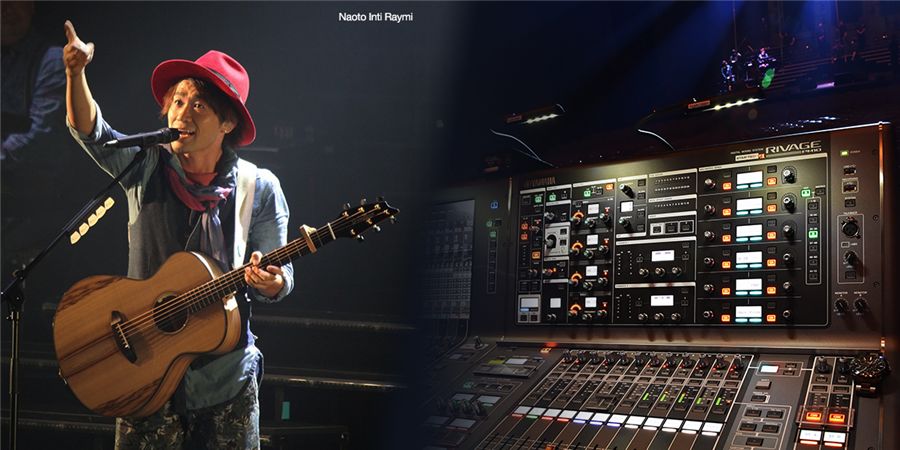
The RIVAGE PM10 Supports a Triumphant Naoto Inti Raymi Hall Tour
(From the June 2016 edition of the bimonthly PROSOUND magazine. Report by Koichi Hanzawa. Photos by Hiroshi Tsuchiya.)
The Yamaha PM series has exemplified innovation and refinement ever since the analog console era, with each new model surpassing previous generations and receiving accolades throughout the pro audio scene. There was a lull in the PM lineup after the release of the PM1D in 2001 and the PM5D/PM5D-RH in 2004, while later digital consoles from the M7CL to TF series became familiar sights in an ever-expanding range of applications and environments. Those consoles have played a major role in making digital mixing the new norm.
Two years ago, 14 years after the release of the PM1D, the new flagship RIVAGE PM10 digital mixing console was announced. The console was first shown to large crowds at the Inter BEE electronics show, and the new flagship “PM” began shipping later that year. In this report we’ll be talking to the STAR*TECH sound company, an early RIVAGE PM10 adopter, who used the console for a nationwide hall tour featuring singer/songwriter Naoto Inti Raymi in 2016.
Naoto Inti Raymi achieved stardom after travelling the globe in search of inspiration and later publishing his travel journals and creating music that resonated deeply with fans throughout his native Japan. Born Naoto Nakamura, he adopted “Inti Raymi,” Incan for “festival of the sun,” as his stage name in 2005.
We interviewed STAR*TECH engineer Yoshihiro Takada to get a feel for the console’s sound and operability, and Hiroaki Sakaba of Yamaha Music Japan who provided additional product information.
Profile: Yoshihiro Takada
Born in 1979 in Sapporo, Hokkaido, Japan. Yoshihiro set his sights on becoming a sound engineer while studying at the electro-mechanical department of his industrial high school. He had always had a talent for fixing and tinkering with machines, and eventually began working part time at a sound company. That company also ran live houses and rehearsal studios where he gained experience repairing a wide range of equipment and came into contact with PA gear for the first time. He also had a passion for music, and was intrigued by the live performances he saw and heard. After a while he began assisting the live sound staff, and his primary focus gradually shifted to sound reinforcement.
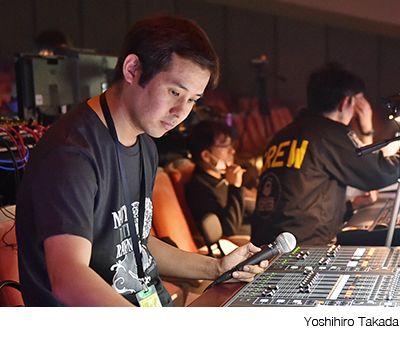
PROSOUND: Where did you go from there?
Takada: After graduating from high school my desire to work in the live sound field was strong. The company I had been working at part time introduced me to a sound company in Tokyo called “Move,” so I moved to Tokyo. Luckily, they put me to work on a hall tour almost immediately. I spent more than 10 years with that first company. They had connections to STAR*TECH, and after a brief stint as a freelancer I joined STAR*TECH full time.
PROSOUND: When did you start working for STAR*TECH?
Takada: I started in 2010. Back in 2003, while I was still with Move, I was assigned to numerous TV related jobs, tours, and other work that originated from STAR*TECH.
PROSOUND: Is there any job that stands out in your memory?
Takada: One job that Move received from STAR*TECH in 2003 when I was a Move employee involved setting up a 360° theater in a circular space at the observation deck of a TV station, and providing a modified form of 7.1 channel surround sound. We used a Pro Tools DAW to synchronize the movement of sound images with visuals, which was quite an advanced application for 2003. That was a turning point. After joining STAR*TECH I worked with a number of artists from overseas, and from there became involved in world tours that brought me into contact with sound companies and staff all around the world, as well as wide range of equipment. It was an incredibly valuable experience.
PROSOUND: Is there anything you pay particular attention to when heading out to a job?
Takada: One thing I concentrate on is trying to achieve a deeper understanding of the music I love. Another is, although I like the equipment and can relate to it naturally without having to force myself, I do not want to arrive at a job without knowing everything I need to know about the job and equipment at hand. I want to be fully prepared before I head out the door. That, to me, is a vital part of the job. Sound systems are rapidly becoming more complex, and a lack of understanding about just one small part of the system can lead to total failure. No sound. When something like that happens with a digital console you have to be able to figure out if the problem is simply a setup error or an equipment malfunction. If you can’t do that, you simply cannot be responsible for the sound. Even if you can’t achieve a level of quality that is consistent with your personal goals, I believe that you at least need the knowledge and understanding to deliver acceptable performance in any situation.
From PM1D to PM10
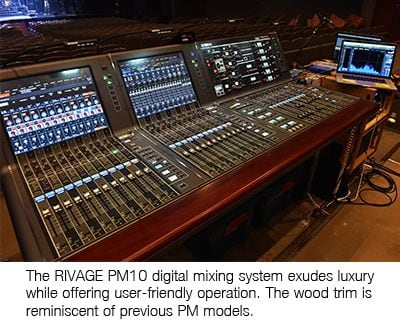
PROSOUND: So tell us about the RIVAGE PM10. Perhaps Mr. Sakaba can start by telling us about the RIVAGE name.
Sakaba: “Rivage” means “riverbank.”
PROSOUND: It’s an interesting name, and we’d like to go into more detail about the background and meaning, but we’ll leave that for another time. This interview took place on March 28 at the Kanagawa Kenmin Hall on the second day of the Naoto Inti Raymi tour mentioned above, which would normally be a bad time for an interview. Thank you for taking the time to talk to us. Watching the rehearsal from the wings we noticed that you already seem to be very familiar with the console. Operation looks very smooth.
Takada: Personally, I prefer consoles designed like this one, with two surfaces rather than one flat surface with no separation. The “dual slope” design of the PM10, with the screens raised upward, provides easier access to all the controls and is much more comfortable to operate. The PM10 definitely falls into the category of “designs I like.”
PROSOUND: Because it’s a tool, and it’s always preferable to use a tool you like.
Takada: That’s right.
PROSOUND: Tell us about the process that led to adopting the PM10.
Takada: STAR*TECH had been using the PM1D for large jobs like this, but then two years ago when information about the PM10 was released …
Sakaba: It was announced in November of 2014.
Takada: I’d have to say that the timing was perfect. The PM1D was already about 15 years old, parts for repairs were becoming difficult to find, and we were thinking about what would come next. We asked Yamaha Music Japan for a demonstration, and not only was our impression of the console very positive, but delivery timing was just right for an upcoming tour.
PROSOUND: You’ve already used the console on actual jobs, so we’d like to ask questions covering two main categories. The first is sound quality and related characteristics, and the second is operability. Starting from the second category, the console is used on tours so it has to be transported. Is it easy to move around?
Takada: I think it weighs about the same as other consoles in the same class. Probably around 80 kilograms?
Sakaba: It weights 86 kilograms. 10 kilograms less than the PM5D.
Takada: When packed in its flight case we use six people to move it around for hall performances to ensure safety. As for the console’s operability, the PM10 selected channel section that was previously located on the left side of Yamaha consoles has been moved to the right. This is just a small gripe, but I operate the vocal fader with my right hand so having the selected channel section on the left was convenient for me. It has taken a while to adjust to the new location.
PROSOUND: That means you have to reach over your right hand and possibly over the display.
Takada: Exactly. But it really doesn’t matter if it’s a Yamaha console or a console from some other manufacturer, there’s always a need to adjust.
PROSOUND: You mean that position changes are just a matter of adjusting?
Takada: Yes. The two-level design of the PM10 puts all controls within easy reach. No real effort is needed to reach anything. That makes the console comfortable to use. If the engineer has to make large movements the sound he hears will change because of reflections from the console. It is important to be able reach all necessary controls without having to move too much.
PROSOUND: We have heard that you’re using an original audio transfer standard too.
Sakaba: A few other details have changed too. The way scenes are set up has changed somewhat from the previous Yamaha style, for example. We are proposing a slightly different approach.
PROSOUND: We have heard that you’re using an original audio transfer standard too.
Sakaba: That’s right. Our original TWINLANe protocol is being used for the first time.
PROSOUND: Does it connect via coaxial or LAN cables?
Sakaba: TWINLANe employs optical cables to transfer 400 channels of 96 kHz, 32-bit audio over long distances with extremely low latency. The I/O and DSP units are connected by optical cables in a ring configuration.
PROSOUND: We’re talking to you at the March 28th concert venue. How many shows have you done thus far in this tour, and have set up and take down been smooth?
Takada: Yesterday’s show was the eighth, and so far everything has gone very smoothly.
Dependable Mixing Operation
PROSOUND: You have already mentioned the position of the selected channel section, but how do you feel about the console’s mixing operation now that you’ve been through eight rehearsals and shows?
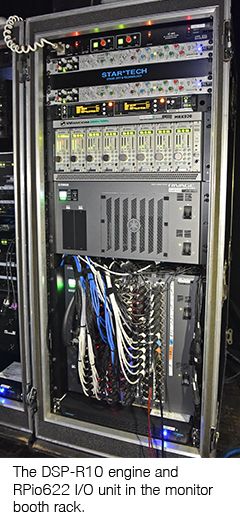
Takada: The overall approach is similar to traditional Yamaha consoles. It is close to the CL and QL series consoles in many ways. But of course there are considerably more functions and display items. There are 144 inputs, 72 mix buses, and 36 matrix buses. That’s a total of 108 buses that require metering and display space in general. The bays organize the faders in groups of twelve, and numerous custom fader banks for each bay increases complexity as well. The system can be arranged to suit your own working style, and although it is very convenient in that respect, it does require some study to use fully.
PROSOUND: For a tour you can arrange mixing scenarios on a timeline and make detailed settings for each individual song, for example.
Takada: Yes. Choosing a mixing approach and finding an optimum fader layout can make a big difference in the workflow. As I mentioned earlier, I carefully prepare the console setup beforehand, but that previously involved reverting to the original layout multiple times. With the Yamaha console, however, each bay has its own input and output channels so you can handle the same function with any bay without having to think about custom fader banks. That’s convenient. There’s normally no need to take any action to bring the controls or parameters you need into view, and the functions of the controls rarely change so you always know where things are. It is a very user-friendly console.
A New Level of Sound Quality from Superb Preamps
PROSOUND: Now let’s get to the heart of the matter and discuss the console’s sound. What was your first impression?
Takada: The instant I heard it I could tell that the resolution was extremely high. The 96 kHz sample rate no doubt contributes to that impression, but the Yamaha still stands out even when compared to consoles with that same specification from other manufacturers. I’d say it is even a little different from previous Yamaha consoles. The sonic performance is at a whole new level. I have used the PM5D on previous Naoto Inti Raymi tours, and although the reproduction is similarly faithful to the source, my impression of the PM10’s resolution is somewhat different. It’s difficult to put into words, but it’s as though the highs and lows are extended while maintaining a natural sound. Some engineers might interpret the high end as being emphasized, but I think it can be best described as high resolution.
PROSOUND: Mr. Sakaba, I assume the improved sound quality is due to refinements in both the analog and digital sections, as well as overall improvements. Can you tell us what contributes most to the sound that Mr. Takada is describing?
Sakaba: We believe that the preamplifiers are extremely important, and spent a long time developing the circuitry used in the PM10. Of course all of the technology and detail that went into the PM10 is worthy of flagship status. The original high-capacity TWINLANe network mentioned previously makes an important contribution too. But in any digital console it is the preamplifiers that have the greatest influence on the sound. In addition to meticulous trial and error development, the SILK processing featured in the preamplifiers offers additional sonic benefits. The Yamaha philosophy of providing a “white canvas” that the engineer can color with tools we provide has been successfully applied in the PM10.
PROSOUND: Mr. Takada, you mentioned high resolution, but how do you feel about the quality of the preamplifiers?
Takada: I have used a large number of consoles in the past, and I’d have to say that the PM10 preamplifiers are clearly the best I’ve heard. Akira Shimura, the head of our company, describes the sound as being “in the right place,” and as having a musical quality that makes achieving the right balance easy. The sound that is being produced on stage is the sound you hear from the console. It doesn’t come out flat, but retains a distinctly musical depth and dimension that is just magnificent. The high end is clear, and the resolution is outstanding.
From Color to Choice: Unique SILK Processing
PROSOUND: It is interesting that in the world of sound reinforcement “normal” is the highest goal. If you can raise the fader and say “that sounds normal” you’ve got the basics right! Mr. Sakaba mentioned the concept of laying a variety of colors on a canvas. One of those colors is SILK processing by Rupert Neve. Tell us about it.
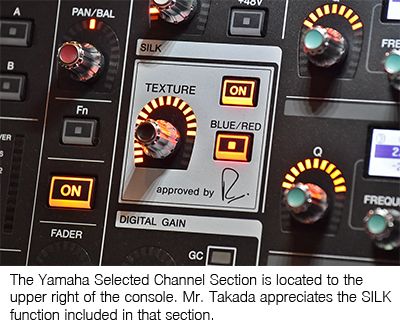
Takada: I find it to be an extremely convenient tool and use it freely. My basic approach is to start by creating a mix without using any “colors” at all. Then SILK might be added as a subtle spice to further build the mix and create a type of definition that EQ can not achieve. The choices provided by SILK are BLUE and RED, with BLUE providing a tighter low end for extra punch and projection. The effect of RED, on the other hand, is most noticeable in the high end. A little RED can be added to make a sound that seems to be buried in the mix stand out. It can be particularly effective with acoustic guitar or vocals, bringing the sound to the front without making it sound peaky the way EQ does. It is a tool that I value very highly.
PROSOUND: We have barely scratched the surface of the RIVAGE PM10, but can you sum up your overall impression of how the console performs in the live sound environment?
Takada: The number of inputs and outputs provided is probably the maximum that a single person can handle, so mixing capacity is more than sufficient. It is comfortable to use, and I immediately felt that it was a console that could be used for a long time to come. But above all is a new level of sound quality. The improvement in sound quality is astonishing, and that makes it possible to improve my own mixing skills as well. The console demands that I create the finest mixes possible. It almost allows me to “see” the sound. I can hear subtleties that I would never have been able to distinguish before. If I operated the faders the same way I did with previous consoles I’d end up with a rough mix with levels that are all in the wrong places, and that would negatively affect the music. The feel of the faders has been greatly improved too, allowing very delicate control. This console has helped me to improve my listening and mixing skills in a big way, and that in turn leads to new, more effective ways of working. It is a console that is aimed at the future, designed for long relationships and growing stronger with use.
PROSOUND: You mean that you feel it has even more potential?
Takada: Absolutely. It is a console that shows its potential more and more as it is used.
PROSOUND: Since you’re already using it, can you give it a score?
Takada: A top score of 100 points! Maybe even more! It has exceeded my expectations and brought many new ideas to the surface. My evaluation is very high.
PM10 Potential for the Next Generation
PROSOUND: It has long been said that musicians and engineers can rapidly and dramatically improve their skills by using the best tools available. That places a great deal of hope on the PM10, and the anticipation that hinges on its quality is clear from the response from the live sound field. With that as a premise, perhaps you can predict the future for us. Digital consoles will continue to evolve and reach deeper into the art of sound. What kind of growth do you think will bring us closer to the ideal in the near future?
PM10 Potential for the Next Generation

Takada: I think the key will be in networked systems. The PM10 uses the TWINLANe system, but other manufacturers use different systems. There is a great deal of variety. There’s no doubt that the richness of functionality and possible approaches provided by digital consoles is a good thing, but the huge number of choices available is actually a problem for the user, and the cost tends to increase. Personally, I’d rather not have to think about systems or protocols, and would like to be able to simply connect all devices together via a common port. Technically it is quite possible and, for example, would allow users to work from their favorite control surface, including tablets like the Apple iPad. It would be possible to choose stage boxes that ideally suit the performance, or any other devices that the engineer feels would best support the system. That would lead to growth in a number of key areas, and the development of products that could be used for many years.
PROSOUND: Your comments have raised some interesting points, and given us hope for the future. Thank you very much! Well that’s the new RIVAGE PM10! It not only offers enhanced performance, but also operability that will have a positive effect on engineers who use it. That profound viewpoint was apparent throughout the interview. We can expect new ways of working, and outstanding original mixes. Thank you for your time!

